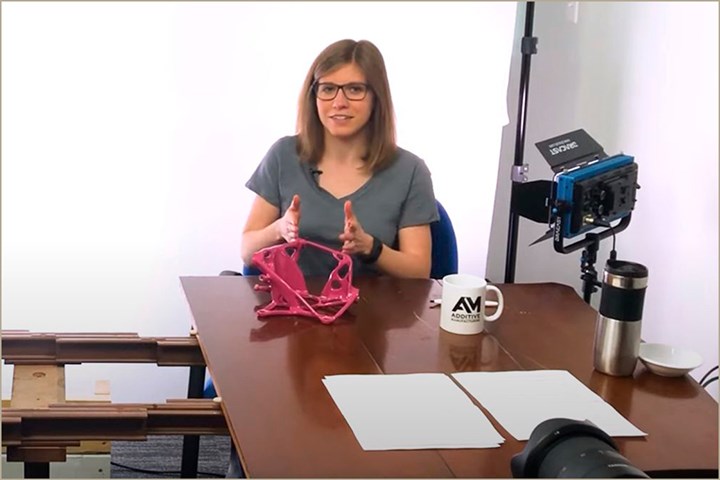Finding Opportunities in the Chaos
2020 has been a disruptive year, but one that will likely contribute to greater 3D printing adoption and more sustainable manufacturing. Stephanie Hendrixson, Senior Editor for Additive Manufacturing and Co-Host of The Cool Parts Show, writes about accelerating trends in AM and staying flexible in the face of a pandemic.
Employee Spotlight Profile
Stephanie Hendrixson, Senior Editor
Additive Manufacturing
The Cool Parts Show
When I started at Gardner Business Media as the IMTS intern in 2012, I never could have predicted that 8 years later, the show would be on hiatus and I’d be moderating virtual education sessions on IMTS Spark. I didn’t know that I’d someday write cover stories and feature articles, that I’d eventually move from Modern Machine Shop to Additive Manufacturing, or that I’d be cohosting a video series about cool 3D printed parts. I didn’t even know I’d still be at Gardner at the end of the summer (even though I very much wanted to work here!). There are plenty of things in life we can’t predict, but I’ve been well-served by staying flexible in changing circumstances and saying “yes” when something interesting comes along.
If you’ve ever met me in person or seen my House Stark mug on a video call you might know I’m a Game of Thrones fan. (Books and show, but we don’t have to talk about Season 8.) There’s a great moment in Season 3 of the HBO series where Petyr Baelish says that “Chaos isn’t a pit. Chaos is a ladder.” Lord Baelish is a character shrewd and ruthless enough to climb that ladder with relish. He wouldn’t just say “yes” to the ladder; he’d trample anyone else in his way.
But I’ve thought about this quote a lot in 2020, and the point feels relevant outside of Westerosi politics: There is opportunity in chaos. Sometimes, opportunity even demands chaos.
This year has been defined by various states of chaos. Like most of us, I expected 2020 to be much like 2018 or 2019. I made plans to attend the same trade shows and set up visits to see additive manufacturing technology in action, as usual. I scheduled vacations. I thought I’d be working out of my still-shiny new office in the Cincinnati headquarters.
But chaos had other ideas. Back in March I cancelled my travel plans. I ordered a proper computer chair and a whiteboard and settled into my newly minted home office. I called off stories that required in-person visits, and instead picked up the coronavirus beat. I threw my energy into covering the ways that 3D printing has risen up during this pandemic.

The home office setup, with novelty mug.
And there, in the chaos, I found some interesting things. 3D printing service bureaus told me how they were getting orders to make parts that would normally have come from overseas, that would have been made through a conventional process. The 3D printed PPE boom saw manufacturers and makers alike all churning out face shield visors and brackets, ear savers, door pulls, and more. And then the biggest surprise of all: Suppliers and manufacturers all across the country formed a collaboration to 3D print nasopharyngeal test swabs, maybe the biggest experiment in decentralized, distributed manufacturing to date.
To be fair, most of these examples are indicative of trends that were already in progress prior to coronavirus. The fact that 3D printing is based on digital files has made distributed manufacturing a largely unrealized possibility for quite a while. Additive manufacturing adoption has been growing, and its application for manufacturing end-use parts has dramatically expanded in just the five years I’ve been reporting on the technology.
But the chaos of the pandemic accelerated these trends. It has made 3D printing more visible to manufacturers, industries and people who might not have thought about it otherwise. It has illuminated 3D printing as a ladder out of the chaos, and I for one am pretty convinced we’ll see even more AM adoption as businesses reimagine their supply chains post-pandemic.
As an editor of Additive Manufacturing and cohost of The Cool Parts Show, a series that exists specifically to celebrate use cases for AM, this is all pretty intriguing to me. Part of the job is being a little bit of a cheerleader for 3D printing, and if 2020 leads to new uses and applications, that means more success stories. It means AM grows, and I get to cover it.
There’s another opportunity I see here alongside AM’s growth potential though. I’ve done quite a bit of reporting on sustainability as it pertains to 3D printing this year (most recently with #CircularEconomyWeek, a series of bite-sized videos covering how the concept intersects with AM). In the last six months or so I’ve learned that getting to sustainable manufacturing and a more circular economy is just as disruptive to an organization as implementing additive manufacturing — and if you’re tearing up the carpet already, might as well repaint the walls too, right?

Sign(s) of the times: Filming a socially distanced episode of The Cool Parts Show, focused on lightweighting an electric vehicle. Pandemic, sustainability and 3D printing all represented in one shot.
I’m speculating, but it seems likely we’ll see more instances of 3D printing and sustainability overlap like custom, on-demand products; localized manufacturing; recycling programs for used items; and parts held as digital as opposed to physical inventory. The chaos has revealed additive manufacturing and sustainable manufacturing as two potential ladders, two potential ways forward, and I see a good case for advancing both together.
On a personal note, I’ve also found some opportunities in the chaos myself. I’ve gotten tons of practice at hosting virtual events and filming via video calls. I’m doing more writing than ever before. I’m also finding more time for sleep, for exercise, for baking bread. (So much bread that I actually wrote an ebook on sourdough.) I’m enjoying the view out my home office window and learning about all the different varieties of birds that visit our array of feeders. I’ve come to understand the daily rhythms of my neighborhood, and the oddly consistent routines of my cat. The experience of 2020 hasn’t been so much disruptive as it has been grounding in my case, and I hope to carry some of that grounded-ness back into our future normalcy.
Need more information?
Stephanie Hendrixson, Senior Editor
Additive Manufacturing
513-527-8949
Twitter
LinkedIn
About the Author
Stephanie Hendrixson
Stephanie (Monsanty) Hendrixson reports on 3D printing technology and applications as senior editor for Additive Manufacturing, and is also co-host of The Cool Parts Show, a video series that highlights unique, unusual and weird 3D printed parts. She got her start in manufacturing media in 2012, through an internship with AM's sister publication Modern Machine Shop, and continues to contribute to MMS as a guest blogger.
Stephanie is a current co-ambassador for the Cincinnati chapter of Women in 3D Printing (Wi3DP). In 2019 she was named among Temboo’s 20 Women in Manufacturing That Are Influencing the Industry, and previously appeared in a panel discussion on “Digital Transformation: Gaining a Competitive Advantage with Data and Diversity” hosted by Women in Big Data at IMTS 2018.
Stephanie holds a B.A. in English literature and history from the University of Mount Union, as well as an M.A. in professional writing from the University of Cincinnati. She currently serves on the UC Professional Writing Advisory Board.
Stephanie is an avid runner, food enthusiast and sourdough baker. She lives in Ohio with her husband Paul and rescue cat Artemis.
RELATED CONTENT
-
3 Major Trends in Manufacturing (And They All Begin with “A”)
Peter Zelinski, Editor-in-Chief of Additive Manufacturing and Modern Machine Shop, sees 3 big, major, long-term trends that continue to reshape manufacturing.
-
26 Relevant Print Marketing Statistics: 2022 Ad Spending & Impact
Print marketing is not dead. Its impact on consumer brand recall and purchase decision is worth considering, especially if you want to implement an integrated, multi-channel approach to your marketing strategy. This article on marketing trends and predictions can provide more insights on strategies you can use for your business or marketing clients.
-
How Best-Practice Segmentation Delivers Faster and More Profitable Growth
There are many approaches to customer and market segmentation. The best method will depend on the business and its goals. This article explores 4 approaches to segmentation, 5 steps to create a successful customer segmentation model, 3 key data considerations, and 5 segmentation best practices. Note: Anyone in the Gardner community who uses GW17Lucky will receive a 17% discount on The Market and Customer Segmentation Workbook. It will only be good for this workbook and will be effective from February 20th through St. Patrick’s Day, March 17th, midnight central time. It will automatically expire at that time.


